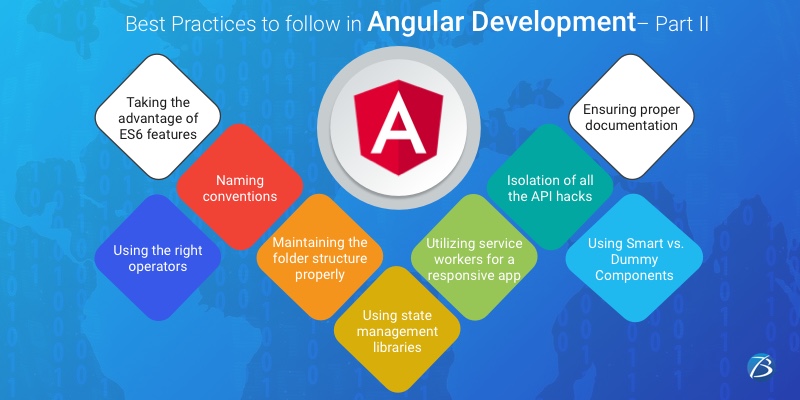Reasons to choose Angular for architecting an Engaging and Attractive Website!


Traditional website designs fail to achieve the desired results any longer. Modern-day users expect websites to be not only intuitive and engaging but also visually attractive and decked up with rich features. One of the most befitting frameworks that satisfy this challenging requirement is Angular. Angular is an open-source JavaScript framework that came into being in 2009 and has been made future-ready by the release of frequent revamped versions by the Angular team, the latest one being Angular 10. This highly marketable framework excels in developing the creative components of a website and hence is a popular pick for website creators. Top brands such as Lego, PayPal, The Guardian, Weather, Netflix, etc. have leveraged Angular development services to build spectacular websites.
This article discusses the role of Angular in creating an engaging and visually appealing website design.
The role of Angular in creating an attractive and engaging website design
Have a look at the distinctive capabilities of Angular in the realm of web development!
Model-View-Controller approach
Angular’s MVC (Model View Controller) architecture splits the app into three distinct components – Model, View, and Controller. The Model maintains data, View displays necessary data and Controller acts as a bridge to connect View and Model. MVC approach eases out the task of Angular app developers while creating Single Page Applications and saves their time as well.
High Scalability
AngularJS development allows one to resize or alter components, modules, logical view, etc. through all stages of the developmental cycle. Therefore, the unidirectional flow is maintained even when developers create new functionalities or extend the existing logic.
Presence of Dependency Injection
Dependency Injection is a design pattern wherein an object bestows dependency on another object. With Angular, the dependencies run alongside their components and this enables the classes to obtain dependency from external sources. Consequently, a tree of dependency injectors is created which can be changed without the need to reconfigure its components. Moreover, owing to its hierarchical structure, it is clearly defined how alterations made to a certain element affects the function of other elements. Thus, this feature enhances performance and also speeds up development.
Lazy Loading
Lazy loading is a unique feature of AngularJS front-end development that enables asynchronous loading of JavaScript components when a particular route is activated. During this action, no other needless page or route is called for. The App Component is loaded as default by the app in the root URL, and the lazy module is loaded asynchronously when users navigate employing the command lazy/load-me.
Ability to create Declarative Interfaces
Angular’s ability to create a declarative UI, is another reason for its high adoption rate. Angular app development employs HTML in place of JavaScript to define the User Interface. HTML is much lesser complicated than JavaScript. Furthermore, owing to HTML usage, the UI components of an Angular web application gain intuitive and declarative properties. Hence, we do not need to manually create flows of the program, Angular’s declarative UI loads components automatically as per the defined page layout and the data. Therefore, the usage of Angular for building websites saves time as well as efforts of front-end developers.
Lightweight code
Since Angular is a framework, code is very precise. Development in Angular requires lesser coding as compared to JavaScript, CSS, and HTML. Moreover, the code is lightweight and readable.
SPA creation benefits
Angular is known for its capability to architect outstanding Single Page Applications as the Angular infrastructure supports journaling, routing, and template usage. Needless to say, SPAs possess a responsive web design and impart a native-like UX on the web.
Benefits of being a framework rather than a library
Angular is often compared to libraries like React.js, when talking about front-end development. But, since Angular is a framework and not a library; the set-up process becomes quicker which speeds up development. Additionally, the Angular eco-system possesses numerous self-libraries. Thus, Angular turns out to be far more beneficial than the libraries like React.js offering similar functionalities.
Ease of Testing
Angular’s capability to mock dependencies allows one to easily test any aspect of the web app starting from its User Interface to the business logic. Also, the separation of modules reduces testing complexities and makes it possible for the users to load only those services that are needed.
Community Backing
The Angular framework has been created and is being maintained by the tech giant Google. As such, the Angular community is equipped with detailed documentation that covers all aspects related to its usage and fixing of issues. Moreover, the community organizes global conferences, and hackathons involving IT professionals across the globe. It also solves the queries of Angular developers through online forums.
![]() Wrap up
Wrap up
In a nutshell, Angular is stuffed with technical goodies that help one to create enticing and engaging websites speedily and in a cost-effective way. So, hiring an Angular App Development Company or Angular App Developers would be a wise decision for those planning to create captivating websites.
If you are looking for Angular App Development Services, reach out to Biz4Solutions, a distinguished Angular App Development Company. We build websites and apps for global clients that boost their ROI. Write to us at sales.enquiry@biz4solutions.com



